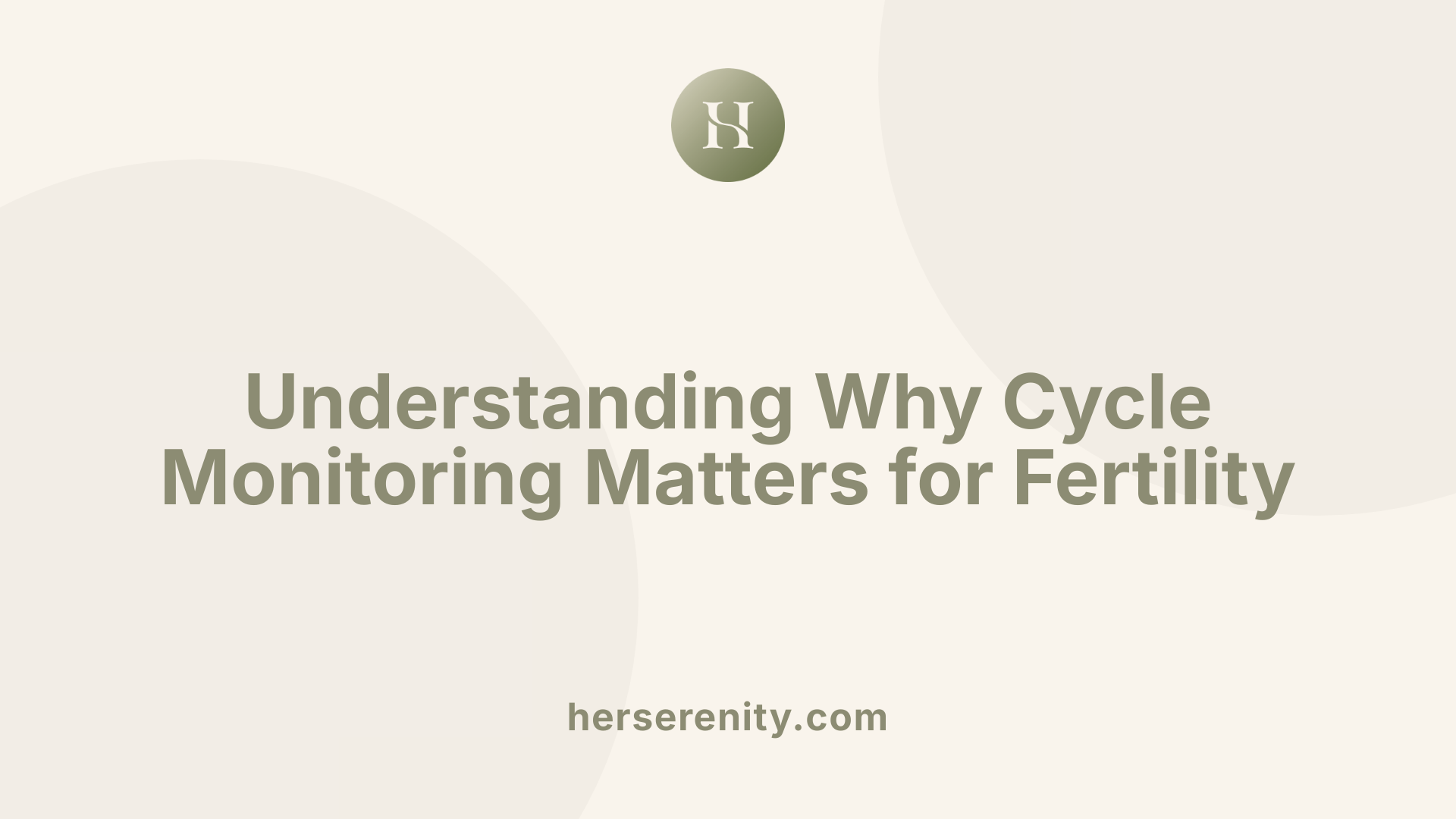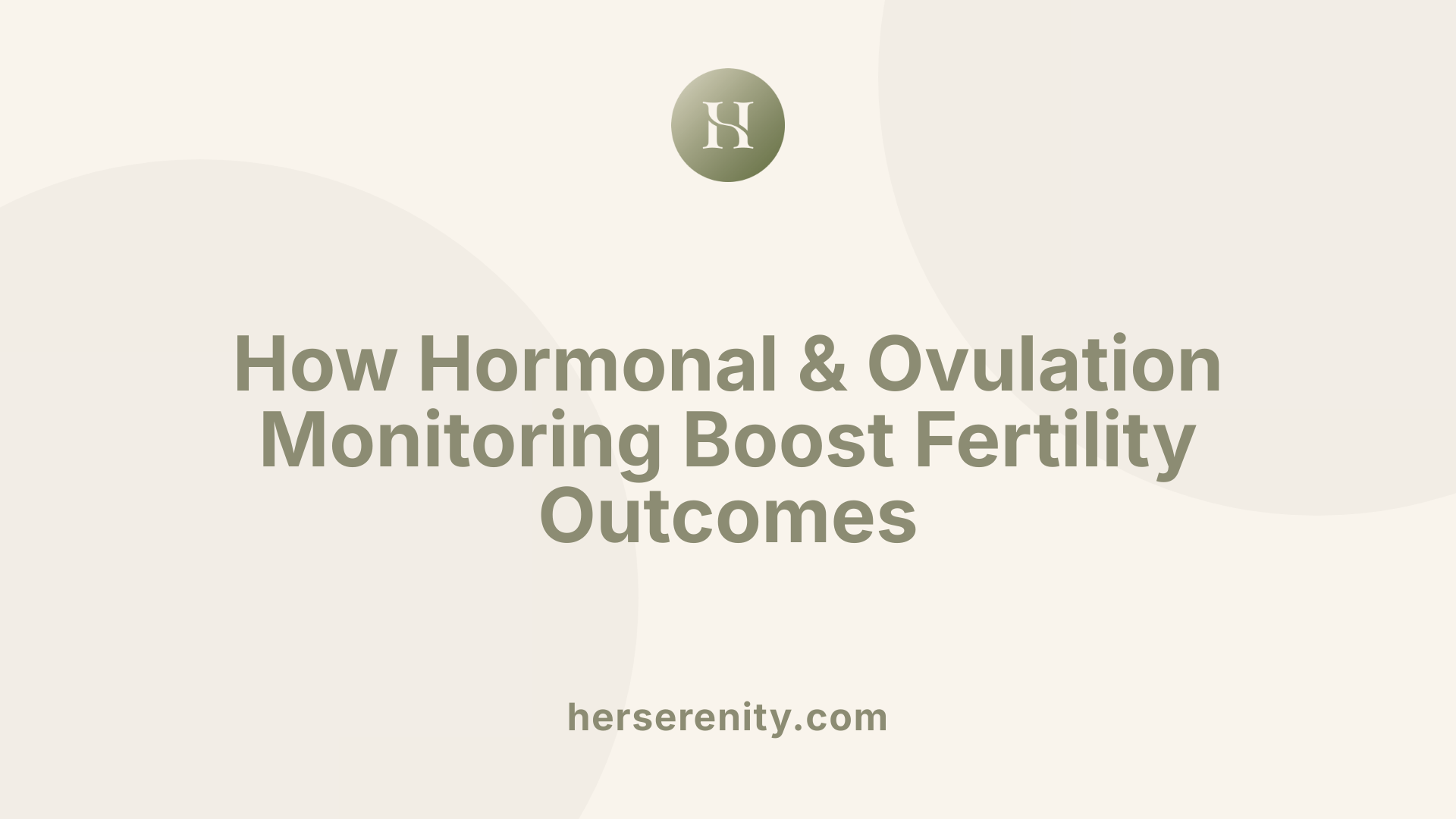The importance of regular cycle monitoring in fertility care
Unlocking Fertility Potential Through Consistent Cycle Assessment

Understanding the Vital Role of Cycle Monitoring in Reproductive Health
Regular cycle monitoring is a cornerstone of modern fertility care, providing crucial insights into a woman’s reproductive functioning. By tracking hormone levels, follicle development, and uterine health, healthcare providers can optimize fertility treatments, increase conception chances, and diagnose underlying reproductive issues early. This comprehensive process, which includes ultrasound examinations and blood tests, forms the foundation for effective intervention and personalized care, especially during assisted reproductive technologies like IVF and IUI.
What Does Regular Menstrual Cycling Signify for Fertility?

Does a regular menstrual cycle indicate good fertility?
A consistent menstrual cycle often suggests that a woman is ovulating regularly, which is an encouraging sign of fertility. When cycles are predictable, it generally means that hormonal regulation is functioning properly, and the reproductive system is performing as expected.
However, a regular period does not guarantee the ability to conceive. Fertility depends on a combination of several factors beyond cycle regularity. For instance, egg quality, the health of the fallopian tubes, sperm health, and uterine conditions all influence the chances of conception.
Various medical conditions can impair fertility even when cycles are regular. Conditions such as endometriosis, polycystic ovary syndrome (PCOS), or structural issues in reproductive organs might not affect the regularity of periods but can still hinder pregnancy.
Infertility affects about 12 to 15% of couples worldwide. It often results from multiple issues like hormonal imbalances or anatomical problems, which necessitate thorough evaluation.
Therefore, while regular menstrual cycles are a positive sign of overall reproductive health, they should not be the sole indicator of fertility. Women facing difficulties conceiving should seek comprehensive reproductive assessment. This assessment may include hormone testing, ultrasound imaging, and other diagnostic procedures to identify underlying issues.
In summary, regular cycling indicates that most hormonal and ovulatory functions are intact, but an in-depth fertility checkup is recommended if conception is delayed despite normal cycles.
Indicators of reproductive health
Monitoring menstrual regularity, evaluating hormone levels, and tracking ovulation signs like basal body temperature or cervical mucus can provide valuable insights.
Factors affecting fertility despite regular cycles
Egg quality, tubal status, sperm health, and uterine environment are crucial factors. Conditions like PCOS or endometriosis often require targeted treatment.
Importance of comprehensive fertility assessment
A detailed fertility evaluation helps identify hidden issues, enabling tailored treatments to improve conception chances. It empowers women and couples with knowledge about their reproductive health, leading to better-informed decisions and therapies.
Comprehending the Purpose of Cycle Monitoring in Fertility Care

What is the purpose of cycle monitoring in fertility care?
Cycle monitoring plays a vital role in understanding a woman's reproductive health by tracking hormonal fluctuations, follicle growth, ovulation, and the condition of the uterine lining. This process typically involves ultrasound examinations and blood tests scheduled at different points during the menstrual cycle.
Through these assessments, healthcare providers can determine whether ovulation occurs normally and evaluate hormonal balance. For women struggling with irregular or missed periods, monitoring helps identify hormonal imbalances or other reproductive issues, such as ovarian cysts or low estrogen levels.
In addition, cycle monitoring guides fertility treatments by pinpointing the fertile window. It allows precise timing for interventions like insemination in intrauterine insemination (IUI) or egg retrieval during in vitro fertilization (IVF). For example, it helps confirm the optimal follicle size—around 18-20 mm—for triggering ovulation.
When using medications to induce ovulation, such as in ovulation induction cycles, regular monitoring ensures that the ovaries respond appropriately and helps prevent complications like ovarian hyperstimulation syndrome (OHSS). During IVF, frequent assessments of follicle development and hormone levels optimize the chances of retrieving mature eggs and increase the likelihood of successful pregnancy.
Overall, cycle monitoring serves as a diagnostic tool to detect reproductive issues early, inform personalized treatment strategies, and improve treatment success rates. It allows adjustments in medication and timing, reducing risks and enhancing outcomes for women seeking conception either naturally or through assisted reproduction.
How does cycle monitoring affect fertility treatments like IUI and IVF?
In fertility procedures like IUI and IVF, meticulous cycle monitoring increases the chances of success by ensuring that procedures are timed perfectly. For IUI, identifying the ovulation day maximizes insemination timing, leading to higher pregnancy rates.
In IVF cycles, monitoring includes baseline ultrasound and hormone tests before ovarian stimulation to assess ovarian reserve and readiness. During stimulation, ultrasounds and blood tests track follicle growth and hormone levels, guiding medication adjustments. The goal is to develop multiple mature follicles—each around 18-20 mm—ready for egg retrieval.
Monitoring also confirms that the uterine lining (endometrium) reaches an optimal thickness (greater than 7 mm) to support implantation. This dynamic tracking helps prevent over- or under-stimulation and identifies issues like inadequate follicle response or poor endometrial development.
The data gathered through monitoring can help clinicians decide when to administer the ovulation trigger, schedule egg retrieval, and plan embryo transfers, all of which critically influence success outcomes.
In summary, cycle monitoring during fertility treatments personalizes interventions, improves timing precision, and reduces the likelihood of cycle cancellation or complications, thereby enhancing overall chances of conception.
Methods and Practices in Cycle Monitoring: An Overview
 Cycle monitoring employs a variety of techniques to assess and track a woman’s reproductive status throughout her menstrual cycle. The most common methods include ultrasound scans and blood hormone tests, which together provide a comprehensive picture of ovarian activity and uterine readiness.
Cycle monitoring employs a variety of techniques to assess and track a woman’s reproductive status throughout her menstrual cycle. The most common methods include ultrasound scans and blood hormone tests, which together provide a comprehensive picture of ovarian activity and uterine readiness.
Ultrasound scans are primarily transvaginal and are used to visualize follicle development, measure the size of ovarian follicles, and assess the thickness of the uterine lining. Typically, ultrasounds are performed on days 2-4 of the cycle to establish baseline conditions and around days 10-12 to observe follicle growth and potential hormone surges. During fertility treatments such as IVF or ovarian stimulation cycles, ultrasounds may be scheduled more frequently, sometimes every few days, to closely monitor ovarian response.
Blood hormone tests complement ultrasounds by measuring levels of key reproductive hormones such as estrogen, luteinizing hormone (LH), and progesterone. These tests are usually scheduled at similar intervals — initial assessments early in the cycle, follow-up tests during peak follicle activity, and post-ovulation checks to confirm ovulation and luteal phase function.
Timing and frequency of assessments vary depending on whether the cycle is natural or medicated. In natural cycles, monitoring might involve fewer visits, mainly to confirm ovulation. During medicated cycles or fertility treatments like IUI and IVF, monitoring is more intensive, with appointments typically scheduled every 2 to 3 days during ovarian stimulation to optimize timing and dosage.
Besides ultrasound and blood tests, additional methods like urine ovulation predictor kits and basal body temperature tracking are also utilized. Ovulation predictor kits detect the LH surge in urine, providing an early indication of impending ovulation. Basal body temperature charts register slight temperature rises post-ovulation, reinforcing the timing deduced from other assessments.
In summary, cycle monitoring combines these methods to gather crucial information about hormonal levels, follicle maturation, and uterine environment. These practices help fertility specialists plan effective interventions, reduce the risk of complications such as ovarian hyperstimulation syndrome, and improve the chances of conception whether through natural means or assisted reproductive techniques.
The Process of Cycle Monitoring Explained

Initial consultations and cycle tracking
The first step in cycle monitoring involves initial consultations with healthcare providers. During this phase, women may undergo baseline assessments, including blood tests and ultrasound scans to gather initial data about hormonal levels and ovarian structure. These steps establish a starting point for tracking changes over the menstrual cycle.
Blood tests and ultrasound scans at different cycle phases
Throughout the cycle, scheduled blood tests and ultrasound scans are performed at specific days—often from Day 2-4 to assess baseline hormones, and around Days 10-12 to observe follicle development. Follow-up evaluations, typically about a week after ovulation, measure hormone levels like progesterone to confirm ovulation and assess the phase's progression.
Assessment of follicle growth and uterine lining
During each monitoring appointment, the healthcare provider assesses the growth of ovarian follicles—looking for a dominant follicle of around 18-20 mm size, which indicates readiness for ovulation. Simultaneously, the thickness and quality of the uterine lining are evaluated; the ideal lining is over 7 mm thick, which is conducive to implantation.
Adjustments to medication protocols based on findings
Based on these observations, doctors can tailor medications to optimize ovarian response and timing for procedures like ovulation triggers, IUI, or IVF. For example, if follicles are developing appropriately, medication doses might be maintained or fine-tuned. If there are concerns such as inadequate follicle growth or thin endometrial lining, treatment protocols may be adjusted to improve chances of successful conception.
In summary, cycle monitoring is an ongoing process involving multiple visits where ultrasound scans and blood tests provide critical information. These insights help in making timely, informed decisions to enhance fertility treatment outcomes and avoid complications.
Impact of Hormonal and Ovulation Monitoring on Fertility Success
 Monitoring hormone levels and ovulation plays a crucial role in enhancing fertility treatment outcomes. Accurate timing of key procedures such as ovulation trigger and egg retrieval depends on vigilant assessment of follicle response and hormonal balance. Ultrasound scans track follicle growth, ensuring eggs reach optimal size—around 18-20 mm—prompting timely administration of trigger medication. Blood tests measure hormones like estrogen, LH, and progesterone to confirm readiness for insemination or retrieval.
Monitoring hormone levels and ovulation plays a crucial role in enhancing fertility treatment outcomes. Accurate timing of key procedures such as ovulation trigger and egg retrieval depends on vigilant assessment of follicle response and hormonal balance. Ultrasound scans track follicle growth, ensuring eggs reach optimal size—around 18-20 mm—prompting timely administration of trigger medication. Blood tests measure hormones like estrogen, LH, and progesterone to confirm readiness for insemination or retrieval.
Personalized treatment plans are developed based on ongoing monitoring data. If hormone levels indicate insufficient follicle development or lining preparation, doctors can adjust medication dosages accordingly. This tailored approach maximizes the chances of successful conception while minimizing risks such as ovarian hyperstimulation syndrome (OHSS).
Early detection of complications, especially OHSS, is possible through regular monitoring. Recognizing signs early ensures prompt intervention, reducing health risks and improving overall cycle safety. These strategies lead to better synchronization of treatments with the natural or stimulated cycle, profoundly influencing fertility success.
In summary, hormone and ovulation monitoring enable precise intervention timing, customized treatment adjustments, and early complication management—factors that collectively bolster the success rates of fertility procedures like in vitro fertilization (IVF). By aligning medical actions with each woman's unique cycle, healthcare providers significantly improve the likelihood of conception and healthy pregnancy outcomes.
The Relevance of Fertility Awareness and Cycle Tracking in Reproductive Health

What is fertility awareness and how does it relate to cycle tracking?
Fertility awareness, often called Natural Family Planning (NFP), is a natural method used to understand a woman’s reproductive cycle. It involves tracking physical signs and hormonal changes to pinpoint fertile days each month.
Cycle tracking helps women recognize when they are ovulating by monitoring signals like basal body temperature, cervical mucus, and menstrual patterns. These signs reveal the timing of ovulation, usually occurring between days 11 and 21 in a typical 28-day cycle.
By keeping detailed records, women can identify their fertile window, generally spanning from days 8 to 21. This allows couples to plan conception when fertility is at its peak or avoid pregnancy by abstaining or using other methods during that time.
When used consistently and correctly, fertility awareness methods can reach about 90% effectiveness in preventing pregnancy or achieving it. It provides a hormone-free, natural approach for women and couples who prefer non-invasive options or want to have more insight into their reproductive health.
Cycle tracking, therefore, is the foundation of fertility awareness, offering essential information about ovulation, hormonal health, and overall reproductive timing. It empowers women with a better understanding of their bodies, supporting family planning, early diagnosis of health issues, and long-term reproductive well-being.
Empowering Women and Enhancing Success in Fertility Care
Regular cycle monitoring is an indispensable element of fertility care, offering invaluable insights that can lead to successful conception and healthy pregnancies. By precisely tracking physiological signs and hormonal fluctuations, women and their healthcare providers can make informed decisions, tailor treatments, and detect issues early. As fertility care advances, ongoing research and increased awareness continue to emphasize the importance of routine cycle assessments—not only to increase the chance of conception but also to foster overall reproductive health. Embracing consistent monitoring practices empowers women, reduces stress, and significantly boosts the likelihood of achieving fertility goals, ultimately contributing to healthier outcomes for families.
References
- Cycle Monitoring: What to Expect, Benefits, and Limitations
- The Significance of Monitoring During Infertility Treatment
- Importance of Cycle Monitoring in Fertility Treatments
- Cycle Monitoring: A Complete Guide for 2025 - Newlife Fertility Centre
- IVF Cycle Monitoring - Bloodwork - Ultrasounds - Tennessee Fertility
- The Importance of Fertility Awareness in the Assessment of a ...
- Transform Your Fertility Treatment with Hormonal Monitoring



































































































